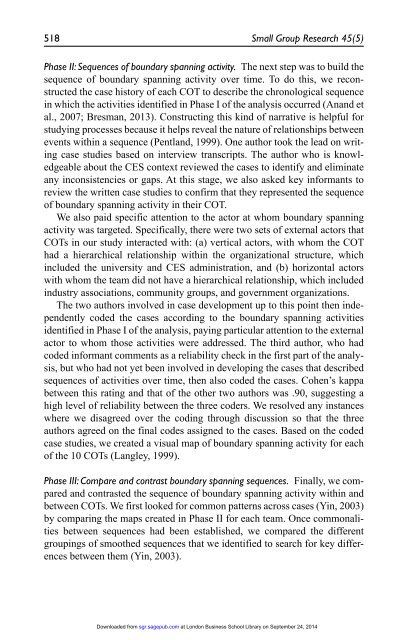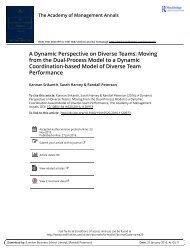The Process of Team Boundary Spanning in Multi-Organizational Contexts - Sarah Harvey, Randall S. Peterson, and N. Anand
Work teams must increasingly operate in complex environments characterized by multiple external actors beyond team and organizational boundaries. Although previous research demonstrates the importance of boundary spanning activities to team effectiveness, it reveals relatively little about the process of boundary spanning in these environments. In this article, we investigated the processes of boundary spanning across multiple external actors in 10 cross-organizational teams. We identified three sequences for reaching out to external actors: (a) moving inside-out from vertical actors inside the host organization to horizontal actors outside of the host organization, (b) moving outside-in from horizontal actors to vertical, and (c) staying-inside with vertical actors from the host organization. Our observations suggest that inside-out and outside-in sequences were more successful than simply pleasing the host organization. We build on our empirical findings to develop a process theory of how team boundary spanning activities across multiple external actors influence team effectiveness. Our research underscores the importance of a team’s interactions with actors in its external environment beyond those in an immediate supervisory role and provides insight into the dynamics of boundary spanning in multi-organizational contexts.
Work teams must increasingly operate in complex environments
characterized by multiple external actors beyond team and organizational
boundaries. Although previous research demonstrates the importance of
boundary spanning activities to team effectiveness, it reveals relatively little
about the process of boundary spanning in these environments. In this article,
we investigated the processes of boundary spanning across multiple external
actors in 10 cross-organizational teams. We identified three sequences for
reaching out to external actors: (a) moving inside-out from vertical actors inside
the host organization to horizontal actors outside of the host organization,
(b) moving outside-in from horizontal actors to vertical, and (c) staying-inside
with vertical actors from the host organization. Our observations suggest
that inside-out and outside-in sequences were more successful than simply
pleasing the host organization. We build on our empirical findings to develop
a process theory of how team boundary spanning activities across multiple
external actors influence team effectiveness. Our research underscores the
importance of a team’s interactions with actors in its external environment beyond those in an immediate supervisory role and provides insight into the
dynamics of boundary spanning in multi-organizational contexts.
Create successful ePaper yourself
Turn your PDF publications into a flip-book with our unique Google optimized e-Paper software.
518 Small Group Research 45(5)<br />
Phase II: Sequences <strong>of</strong> boundary spann<strong>in</strong>g activity. <strong>The</strong> next step was to build the<br />
sequence <strong>of</strong> boundary spann<strong>in</strong>g activity over time. To do this, we reconstructed<br />
the case history <strong>of</strong> each COT to describe the chronological sequence<br />
<strong>in</strong> which the activities identified <strong>in</strong> Phase I <strong>of</strong> the analysis occurred (An<strong>and</strong> et<br />
al., 2007; Bresman, 2013). Construct<strong>in</strong>g this k<strong>in</strong>d <strong>of</strong> narrative is helpful for<br />
study<strong>in</strong>g processes because it helps reveal the nature <strong>of</strong> relationships between<br />
events with<strong>in</strong> a sequence (Pentl<strong>and</strong>, 1999). One author took the lead on writ<strong>in</strong>g<br />
case studies based on <strong>in</strong>terview transcripts. <strong>The</strong> author who is knowledgeable<br />
about the CES context reviewed the cases to identify <strong>and</strong> elim<strong>in</strong>ate<br />
any <strong>in</strong>consistencies or gaps. At this stage, we also asked key <strong>in</strong>formants to<br />
review the written case studies to confirm that they represented the sequence<br />
<strong>of</strong> boundary spann<strong>in</strong>g activity <strong>in</strong> their COT.<br />
We also paid specific attention to the actor at whom boundary spann<strong>in</strong>g<br />
activity was targeted. Specifically, there were two sets <strong>of</strong> external actors that<br />
COTs <strong>in</strong> our study <strong>in</strong>teracted with: (a) vertical actors, with whom the COT<br />
had a hierarchical relationship with<strong>in</strong> the organizational structure, which<br />
<strong>in</strong>cluded the university <strong>and</strong> CES adm<strong>in</strong>istration, <strong>and</strong> (b) horizontal actors<br />
with whom the team did not have a hierarchical relationship, which <strong>in</strong>cluded<br />
<strong>in</strong>dustry associations, community groups, <strong>and</strong> government organizations.<br />
<strong>The</strong> two authors <strong>in</strong>volved <strong>in</strong> case development up to this po<strong>in</strong>t then <strong>in</strong>dependently<br />
coded the cases accord<strong>in</strong>g to the boundary spann<strong>in</strong>g activities<br />
identified <strong>in</strong> Phase I <strong>of</strong> the analysis, pay<strong>in</strong>g particular attention to the external<br />
actor to whom those activities were addressed. <strong>The</strong> third author, who had<br />
coded <strong>in</strong>formant comments as a reliability check <strong>in</strong> the first part <strong>of</strong> the analysis,<br />
but who had not yet been <strong>in</strong>volved <strong>in</strong> develop<strong>in</strong>g the cases that described<br />
sequences <strong>of</strong> activities over time, then also coded the cases. Cohen’s kappa<br />
between this rat<strong>in</strong>g <strong>and</strong> that <strong>of</strong> the other two authors was .90, suggest<strong>in</strong>g a<br />
high level <strong>of</strong> reliability between the three coders. We resolved any <strong>in</strong>stances<br />
where we disagreed over the cod<strong>in</strong>g through discussion so that the three<br />
authors agreed on the f<strong>in</strong>al codes assigned to the cases. Based on the coded<br />
case studies, we created a visual map <strong>of</strong> boundary spann<strong>in</strong>g activity for each<br />
<strong>of</strong> the 10 COTs (Langley, 1999).<br />
Phase III: Compare <strong>and</strong> contrast boundary spann<strong>in</strong>g sequences. F<strong>in</strong>ally, we compared<br />
<strong>and</strong> contrasted the sequence <strong>of</strong> boundary spann<strong>in</strong>g activity with<strong>in</strong> <strong>and</strong><br />
between COTs. We first looked for common patterns across cases (Y<strong>in</strong>, 2003)<br />
by compar<strong>in</strong>g the maps created <strong>in</strong> Phase II for each team. Once commonalities<br />
between sequences had been established, we compared the different<br />
group<strong>in</strong>gs <strong>of</strong> smoothed sequences that we identified to search for key differences<br />
between them (Y<strong>in</strong>, 2003).<br />
Downloaded from sgr.sagepub.com at London Bus<strong>in</strong>ess School Library on September 24, 2014
















